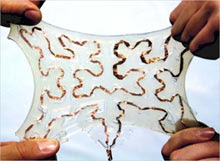A new system adapted from a technology used for underwater cables could lead to touch sensors in clothes and coffee tables.
 |
| A Versatile Touch Sensor |
Technology | Technologies | We live in an increasingly touchy-feely tech world, with various ways for smart phones and tablet computers to sense our finger taps and gestures. Now a much cheaper type of touch technology, developed by researchers at the University of Munich and the Hasso Plattner Institute, could lead to touch sensitivity being added to everyday items such as clothing, headphone wires, coffee tables, and even pieces of paper.
The new touch technology relies on something called time domain reflectometry, or TDR, which has been used for decades to find damage in underwater cables. TDR is simple in theory: send a short electrical pulse down a cable and wait until a reflection of the pulse comes back. Based on the known speed of the pulse and the time it takes to come back, software can determine the position of the problem—damage in the line or some sort of change in electrical conductance.
Patrick Baudisch, professor of computer science at the Hasso Plattner Institute, says engineers noticed in the 1960s that the technology could be used to indicate a touch of a wire. Recently, the ability to sense the short time delay over very short distances has gotten more accurate, which made it possible to use TDR for interactive applications.
The TDR implementation is straightforward, according to Raphael Wimmer, a student at the University of Munich who developed the new approach with Baudisch. For one demonstration, he taped two parallel strips of copper to a piece of paper. Metal clips connect the copper strips to a pulse generator and detector. Pico-second-long electrical pulses are sent out, and if there's any change in capacitance between the two strips of copper—produced by a finger close to or touching the wires, for instance—part of the pulse is reflected back.
An oscilloscope shows the changing waveform produced by the reflected pulse, and software on a connected computer determines the position of the touch. The current setup is a bit clunky, Wimmer admits, but he says it should be feasible to shrink the pulse generation, detection, and position calculation onto a chip.
To make a surface touch-sensitive requires only two wires (or metal traces of conductive ink), which can be configured in various patterns to get the necessary coverage. In contrast, a capacitive touch screen like the one in the iPhone uses a matrix of wires coming out of two sides of the screen. "You have to route them to a controller in special ways, and that's quite complicated," says Wimmer. TDR avoids the engineering challenges of a traditional capacitive touch surface, he says.
"Wimmer's application of TDR to touch is very clever," says Jeff Han, founder and CEO of Perceptive Pixel, a company that is developing large multi-touch displays. He suspects that it could provide new ways of detecting user input like touch sensing along an unmodified headphone cable, something that would be difficult to do with traditional sensors.
Over the next couple of months, Wimmer says, the researchers will be testing ways to shrink the TDR system design into a chip. He says he's also exploring the possibility of using light pulses in fiber optics as well as electrical pulses in cables because light would be immune to the electrical interference common in capacitive touch systems.











0 comments:
Post a Comment